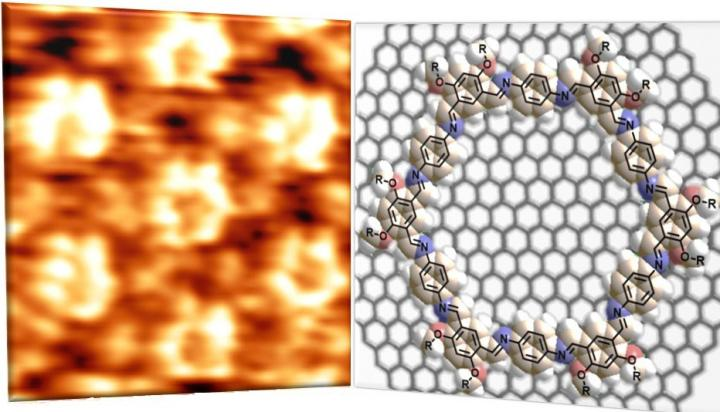Mar 5 2020
Civilizations have advanced through the Stone, Bronze, and Iron Ages over several millennia. Now, it’s the turn of quantum materials to redefine the way humans live, thanks partly to studies performed at McGill University and the Institut National de la Recherche Scientifique (INRS).
 Experimental image of seven macrocycles on a graphite surface acquired through a Scanning Tunneling Microscope (Left) and a simulated macrocycle over a graphene surface (Right). Image Credit: Chaoying Fu.
Experimental image of seven macrocycles on a graphite surface acquired through a Scanning Tunneling Microscope (Left) and a simulated macrocycle over a graphene surface (Right). Image Credit: Chaoying Fu.
According to Professor Emanuele Orgiu, a specialist in quantum materials and researcher at INRS, although quantum materials have a thickness of just a few atoms, they have incredible electrical, magnetic, and optical properties. The study performed by Professor Orgiu focuses on producing patterns on the quantum materials’ surface to change their properties.
“The shape of the drawings helps determine the properties imparted upon the surface,” he explained.
Professor Orgiu’s study has promising applications for (opto)electronic devices, like photosensors and transistors and even for biosensing devices.
The quantum materials specialist has made a major breakthrough by producing big circular molecules, called macrocycles, on the surface of graphite. Graphite contains a stack of one-atom-thick sheet of carbon, that is, graphene. The latter is regarded as a quantum material.
Think of macrocycles as tiny Lego blocks. It’s impossible to build a ring in solution, a homogeneous mixture in which the blocks are diluted. But you can do it if you put them on a table.
Emanuele Orgiu, Study Lead Author and Professor, Institut National de la Recherche Scientifique
The study results were published online in the ACS Nano journal on February 18th, 2020.
In brief, Chaoying Fu, the postdoctoral researcher in Orgiu’s team and the study’s first author, has identified a new way, where macrocycles can be used to draw molecular patterns on the surface of a material.
The macrocycles are deposited on the surface in solution and only the molecules are left once the liquid has evaporated. We can predict how they will fit together, but the alignment happens naturally through the interactions with neighbouring molecules and the surface.
Emanuele Orgiu, Study Lead Author and Professor, Institut National de la Recherche Scientifique
The research was carried out in association with Dmitrii F. Perepichka, a professor in the Department of Chemistry of McGill University. Perepichka’s know-how helped understand how specific molecules could organize themselves on the graphite’s surface.
This is a great example of the power of a multidisciplinary approach where we combined organic synthesis and surface science. The level of control we achieved over the shape and the structure of synthesized molecules is quite remarkable.
Dmitrii F. Perepichka, Professor, Department of Chemistry, McGill University
According to Orgiu, the size and shape of macrocycles made them the perfect candidate to draw molecular patterns on the surface of graphite.
“The advantage of these molecules is the large pores in their structure. We may eventually be able to use our macrocycles as a frame and decorate the pores with biomolecules that would promote biosensing properties of the surface. This is certainly one of our next steps for future projects,” Orgiu concluded.
The study titled “Surface-Confined Macrocyclization via Dynamic Covalent Chemistry” was authored by Chaoying Fu and team.
The researchers received financial support from the Quebec Centre for Advanced Materials (QCAM), the Natural Sciences and Engineering Research Council of Canada (NSERC), the National Natural Science Foundation of China, and the Czech Science Foundation (GACR).